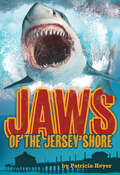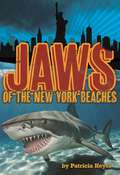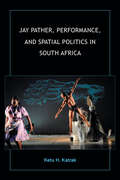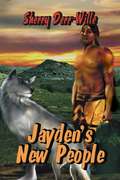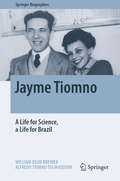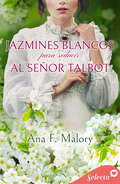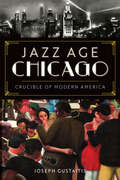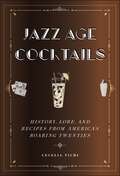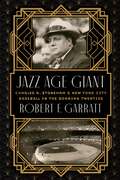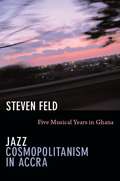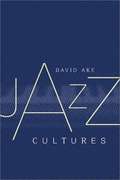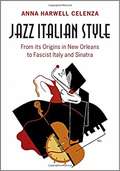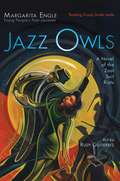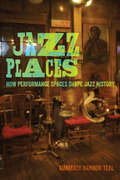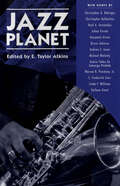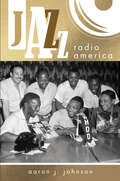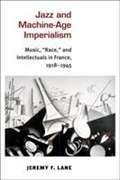- Table View
- List View
Jaws of Darkness: Book Five of The Darkness Series
by Harry TurtledoveThe grand conflict for control of the continent of Derlavai rages on, in a battle with all the drama and terror of the Second World War-only the bullets are beams of magical fire, the tanks and submarines are great lumbering beasts, and the fighters and bombers are dragons raining fire upon their targets. Yet hope may be dawning at last. The terrible onslaught of the conquering forces of Algarve-who power their battle magics with the life energy of their murdered victims-begins to founder as it runs into Habbakuk: a sorcerous ship of ice used by embattled nations of Lagoas and Kuusamo to ferry their deadly dragons across the seas to strike at the very heart of Algarvian power.But though the tide has begun to turn, the conflict is far from over. The widely disdained Kaunians still struggle desperately to escape as the Algarvians kill them by the thousands-for life energy, but also simply for the crime of being Kaunian. And as the deaths of innocent civilians on both sides continue to feed the flames of war, those who have struggled to survive and preserve their freedom have only their passions to see them through. . . .
Jaws of the Jersey Shore (Arcadia Children's Books)
by Patricia HeyerIn this middle-grade adaptation of Shark Attacks of the Jersey Shore , author Patricia Heyer dives into the history and lore of shark attacks along New Jersey's coast. Every summer, thousands of people flock to the boardwalks and beaches of the Jersey Shore looking for fun and relaxation. But some come face to face with much more. A boy paid a gruesome price for teasing a trapped shark in the first recorded attack in 1842. Three bloody attacks of 1960 left one man's limb amputated. The horrific summer of 1916 included seven attacks within two weeks, sparking the man-eating reputation that sharks still have today. These stories and more have been adapted for younger readers brave enough to dive in to our shark-infested waters.
Jaws of the New York Beaches (Arcadia Children's Books)
by Patricia HeyerIn this middle-grade adaptation of Shark Attacks of New York, author Patricia Heyer dives into the history and lore of shark attacks along New York's coast. Every summer, thousands of people flock to Coney Island, the Rockaway, and all along Long Island's southern coast for some of the most beautiful beaches on the east coast. But some come face to face with much more.
Jay DeFeo and The Rose
by Jane Green Leah LevyIn the collection, eleven distinguished art and cultural historians - Bill Berkson, Niccolo Caldararo, Richard Candida Smith, Walter Hopps, Lucy R. Lippard, Greit Marcus, Sandra S. Phillips, Marla Prather, Carter Ratcliff, David A. Ross, and Martha Sherrill - unfold the story of the creation, as well as the tricky and painstaking rescue, of DeFeo's radiant masterpiece.
Jay Pather, Performance, and Spatial Politics in South Africa (African Expressive Cultures)
by Ketu H. KatrakJay Pather, Performance and Spatial Politics in South Africa offers the first full-length monograph on the award-winning choreographer, theater director, curator, and creative artist in contemporary global performance. Working within the contexts of African studies, dance, theater, and performance, Ketu H. Katrak explores the extent of Pather's productive career but also places him and his work in the South African and global arts scene, where he is considered a visionary. Pather, a South African of Indian heritage, is known as a master of space, site, and location. Katrak examines how Pather's performance practices place him in the center of global trends that are interdisciplinary, multidisciplinary, collaborative, and multimedia and that cross borders between dance, theater, visual art, and technology. Jay Pather, Performance and Spatial Politics in South Africa offers a vision of an artist who is strategically aware of the spatiality of human life, who understands the human body as the nation's collective history, and who is a symbol of hope and resilience after the trauma of violent segregation.
Jayden's New People
by Sherry Derr-WilleDestined to die because of the disappearance of his sister prior to her scheduled sacrifice, Jayden is surprised to find that he, too, has traveled through time so that his life could be saved. When the people who have befriended Javion do likewise for him, he realizes that his life has been saved for a purpose. He soon finds that the daughter of his mentor, Spotted Pony, has become very important to him, but marriage to the girl—who is too young—seems an impossible dream, rather than the all encompassing love of his life. Shining Star is immediately attracted to the handsome stranger her father has befriended. Will he be willing to wait for her? Or, will a winter of separation show him other maidens more suited to him?
Jayhawker
by Patricia Beatty Stephen Marchesi Patricia B. UhrWith the United States on the verge of civil war, Elijah Tully and his father ride out of Kansas as Jayhawkers, guerrilla fighters against slavery. After his father is killed, Lije goes undercover among the proslavery bushwhackers. Swept into a grisly raid, Lije unexpectedly stands face-to-face with his father's killer -- but is vengeance as simple as he once thought?
Jayme Tiomno: A Life for Science, a Life for Brazil (Springer Biographies)
by William Dean Brewer Alfredo Tiomno TolmasquimJayme Tiomno (1920-2011) was one of the most influential Brazilian physicists of the 20th century, interacting with many of the renowned physicists of his time, including John Wheeler and Richard Feynman, Eugene Wigner, Chen Ning Yang, David Bohm, Murray Gell-Mann, Remo Ruffini, Abdus Salam, and many others.This biography tells the sometimes romantic, often discouraging but finally optimistic story of a dedicated scientist and educator from a developing country who made important contributions to particle physics, gravitation, cosmology and field theory, and to the advancement of science and of scientific education, in many institutions in Brazil and elsewhere. Drawing on unpublished documents from archives in Brazil and the US as well as private sources, the book traces Tiomno's long life, following his role in the establishment of various research facilities and his tribulations during the Brazilian military dictatorship. It presents a story of progress and setbacks in advancing science in Brazil and beyond, and of the persistence and dedication of a talented physicist who spent his life in search of scientific truth.
Jayshankar Prasad
by Ramesh Chandar ShahRamesh Chandra Shah has presented the biography of Jayshankar Prasad in this book and has presented the in-depth evaluation of his work. Shah presents Prasad as a writer whose writings are based on the foundation of psychological realism.
Jazmines blancos para seducir al señor Talbot (Los Talbot #Volumen 4)
by Ana F. MaloryCautivada por el atractivo señor Talbot, Cecile no dudará en dejarse llevar por la curiosidad que él, y las sensaciones que experimenta cuando está a su lado, le provocan. Maxwell Talbot está dispuesto a trasladarse a Spalding para hacerle un favor a su reciente estrenado cuñado, el vizconde Gainsborough: encargarse de administrar sus bienes hasta que este y su esposa regresen de su viaje por el continente. Cecile Larson, prima del vizconde, dedica todo su tiempo a la botánica y la llegada del nuevo administrador no suscita en ella el menor interés. Hasta que lo conoce.
Jazz
by Gary Giddins Scott DeveauxIn this vivid history of jazz, a respected critic and a leading scholar capture the excitement of America's unique music with intellectual bite, unprecedented insight, and the passion of unabashed fans. They explain what jazz is, where it came from, and who created it and why, all within the broader context of American life and culture. Emphasizing its African American roots, Jazz traces the history of the music over the last hundred years. From ragtime and blues to the international craze for swing, from the heated protests of the avant-garde to the radical diversity of today's artists, Jazz describes the travails and triumphs of musical innovators struggling for work, respect, and cultural acceptance set against the backdrop of American history, commerce, and politics. With vibrant photographs by legendary jazz chronicler Herman Leonard, Jazz is also an arresting visual history of a century of music.
Jazz (History of American Music, Ninth Edition)
by Paul O. W. Tanner David W. Megill Maurice GerowThe Ninth Edition of Jazz takes students on an extraordinary musical journey through the changing styles and the fascinating history of jazz. With a strong emphasis on listening and an outstanding photo program, Jazz offers an insider's view of the most important music, artists, clubs, and precursors in jazz history. New to the Ninth Edition, personal accounts by major players in the scene -- "Witness to Jazz" -- take students inside the sessions, giving them a firsthand view of the lively context surrounding the growth of this uniquely American art form.
Jazz Age Barcelona
by Robert A. DavidsonOne of the world's renowned centres of culture, Barcelona is also one of the capitals of modernist art given its associations with the talents of Dali, Picasso, and Gaudi. Jazz Age Barcelona focuses the lenses of cultural studies and urban studies on the avant-garde character of the city during the cosmopolitan Jazz Age, delving into the cultural forces that flourished in Europe between the late 1910s and early 1930s. Studying literary journalism, photography, and the city of Barcelona itself, Robert Davidson argues that the explosion of jazz culture and the avant-garde was predominantly fostered by journalists and their positive reception of innovative new art forms and radical politics. Using periodicals and recently rediscovered archival material, Davidson considers the relationship between the political pressures of a brutal class war, the grasp of a repressive dictatorship, and the engagement of the city's young intellectuals with Barcelona's culture and environment. Also analysing the 1929 International Exhibition and the down-and-out Raval District - which housed many of the Age's clubs and bars - Jazz Age Barcelona is an insightful portrait of one of the twentieth century's most culturally rich times and places.
Jazz Age Chicago: Crucible of Modern America
by Joseph GustaitisWhen people imagine 1920s Chicago, they usually (and justifiably) think of Al Capone, speakeasies, gang wars, flappers and flivvers. Yet this narrative overlooks the crucial role the Windy City played in the modernization of America. The city's incredible ethnic variety and massive building boom gave it unparalleled creative space, as design trends from Art Deco skyscrapers to streamlined household appliances reflected Chicago's unmistakable style. The emergence of mass media in the 1920s helped make professional sports a national obsession, even as Chicago radio stations were inventing the sitcom and the soap opera. Join Joseph Gustaitis as he chases the beat of America's Jazz Age back to its jazz capital.
Jazz Age Cocktails: History, Lore, and Recipes from America's Roaring Twenties (Washington Mews Books)
by Cecelia TichiHow the Prohibition law of 1920 made alcohol, savored in secret, all the more delectable when the cocktail shaker was forced to go “underground”“Roaring Twenties” America boasted famous firsts: women’s right to vote, jazz music, talking motion pictures, flapper fashions, and wondrous new devices like the safety razor and the electric vacuum cleaner. The privations of the Great War were over, and Wall Street boomed. The decade opened, nonetheless, with a shock when Prohibition became the law of the land on Friday, January 16, 1920, when the Eighteenth Amendment banned “intoxicating liquors.” Decades-long campaigns to demonize alcoholic beverages finally became law, and America officially went “dry.”American ingenuity promptly rose to its newest challenge. The law, riddled with loopholes, let the 1920s write a new chapter in the nation’s saga of spirits. Men and women spoke knowingly of the speakeasy, the bootlegger, rum-running, black ships, blind pigs, gin mills, and gallon stills. Passwords (“Oscar sent me”) gave entrée to night spots and supper clubs where cocktails abounded, and bartenders became alchemists of timely new drinks like the Making Whoopee, the Petting Party, the Dance the Charleston. A new social event—the cocktail party staged in a private home—smashed the gender barrier that had long forbidden “ladies” from entering into the gentlemen-only barrooms and cafés. From the author of Gilded Age Cocktails, this book takes a delightful new romp through the cocktail creations of the early twentieth century, transporting readers into the glitz and (illicit) glamour of the 1920s. Spirited and richly illustrated, Jazz Age Cocktails dazzles with tales of temptation and temperance, and features charming cocktail recipes from the time to be recreated and enjoyed.
Jazz Age Giant: Charles A. Stoneham and New York City Baseball in the Roaring Twenties
by Robert F. GarrattIn the early 1920s, when the New York Yankees&’ first dynasty was taking shape, they were outplayed by their local rival, the New York Giants. Led by manager John McGraw the Giants won four consecutive National League pennants and two World Series, both against the rival Yankees. Remarkably, the Giants succeeded despite a dysfunctional and unmanageable front office. And at the center of the turmoil was one of baseball&’s more improbable figures: club president Charles A. Stoneham, who had purchased the Giants for $1 million in 1919, the largest amount ever paid for an American sports team. Short, stout, and jowly, Charlie Stoneham embodied a Jazz Age stereotype—a business and sporting man by day, he led another life by night. He threw lavish parties, lived extravagantly, and was often chronicled in the city tabloids. Little is known about how he came to be one of the most successful investment brokers in what were known as &“bucket shops,&” a highly speculative and controversial branch of Wall Street. One thing about Stoneham is clear, however: at the close of World War I he was a wealthy man, with a net worth of more than $10 million. This wealth made it possible for him to purchase majority control of the Giants, one of the most successful franchises in Major League Baseball. Stoneham, an owner of racehorses, a friend to local politicians and Tammany Hall, a socialite and a man well placed in New York business and political circles, was also implicated in a number of business scandals and criminal activities. The Giants&’ principal owner had to contend with federal indictments, civil lawsuits, hostile fellow magnates, and troubles with booze, gambling, and women. But during his sixteen-year tenure as club president, the Giants achieved more success than the club had seen under any prior regime. In Jazz Age Giant Robert Garratt brings to life Stoneham&’s defining years leading the Giants in the Roaring Twenties. With its layers of mystery and notoriety, Stoneham&’s life epitomizes the high life and the changing mores of American culture during the 1920s, and the importance of sport, especially baseball, during the pivotal decade.
Jazz Cosmopolitanism in Accra: Five Musical Years in Ghana
by Steven FeldIn this remarkable book, Steven Feld, pioneer of the anthropology of sound, listens to the vernacular cosmopolitanism of jazz players in Ghana. Some have traveled widely, played with American jazz greats, and blended the innovations of John Coltrane with local instruments and worldviews. Combining memoir, biography, ethnography, and history, Feld conveys a diasporic intimacy and dialogue that contests American nationalist and Afrocentric narratives of jazz history. His stories of Accra's jazz cosmopolitanism feature Ghanaba/Guy Warren (1923-2008), the eccentric drummer who befriended the likes of Charlie Parker, Max Roach, and Thelonious Monk in the United States in the 1950s, only to return, embittered, to Ghana, where he became the country's leading experimentalist. Others whose stories figure prominently are Nii Noi Nortey, who fuses the legacies of the black avant-gardes of the 1960s and 1970s with pan-African philosophy in sculptural shrines to Coltrane and musical improvisations inspired by his work; the percussionist Nii Otoo Annan, a traditional master inspired by Coltrane's drummers Elvin Jones and Rashied Ali; and a union of Accra truck and minibus drivers whose squeeze-bulb honk-horn music for drivers' funerals recalls the jazz funerals of New Orleans. Feld describes these artists' cosmopolitan outlook as an "acoustemology," a way of knowing the world through sound.
Jazz Cultures
by David AkeAke examines the musical identities and styles of several jazz musicians, some canonical and some not, to illuminate how and why identities and styles contribute to the making of the jazz canon.
Jazz Italian Style: From its Origins in New Orleans to Fascist Italy and Sinatra
by Anna Harwell Celenza<p>Jazz Italian Style explores a complex era in music history, when politics and popular culture collided with national identity and technology. When jazz arrived in Italy at the conclusion of World War I, it quickly became part of the local music culture. In Italy, thanks to the gramophone and radio, many Italian listeners paid little attention to a performer's national and ethnic identity. Nick LaRocca (Italian-American), Gorni Kramer (Italian), the Trio Lescano (Jewish-Dutch), and Louis Armstrong (African-American), to name a few, all found equal footing in the Italian soundscape. <p>The book reveals how Italians made jazz their own, and how, by the mid-1930s, a genre of jazz distinguishable from American varieties and supported by Mussolini began to flourish in Northern Italy and in its turn influenced Italian-American musicians. Most importantly, the book recovers a lost repertoire and an array of musicians whose stories and performances are compelling and well worth remembering.
Jazz Moon: A Novel
by Joe Okonkwo&“A passionate, alive, and original novel about love, race, and jazz in 1920s Harlem and Paris—a moving story of traveling far to find oneself&” (David Ebershoff, author of The Danish Girl and The 19th Wife). On a sweltering summer night in 1925, beauties in beaded dresses mingle with hepcats in dapper suits on the streets of Harlem. The air is thick with reefer smoke, and jazz pours out of speakeasy doorways. Ben Charles and his devoted wife are among the locals crammed into a basement club to hear music and drink bootleg liquor. For aspiring poet Ben, the heady rhythms are a revelation. So is Baby Back Johnston, an ambitious trumpet player who flashes a devilish grin and blasts dynamite from his horn. Ben finds himself drawn to the trumpeter—and to Paris, where Baby Back says everything is happening. In Paris, black people are welcomed as exotic celebrities, especially those from Harlem. It&’s an easy life, but it quickly leaves Ben adrift and alone, craving solace through anonymous dalliances in the city&’s decadent underground scene. From chic Parisian cafés to seedy opium dens, his odyssey will bring new love, trials, and heartache, even as echoes from the past urge him to decide where true fulfillment and inspiration lie. Jazz Moon is an evocative story of emotional and artistic awakening set against the backdrop of the Harlem Renaissance and Jazz Age–Paris—a winner of the Edmund White Award and a finalist for the Lambda Literary Award. &“Jazz Moon mashes up essences of Hurston and Hughes and Fitzgerald into a heady mixtape of a romance: driving and rhythmic as an Armstrong Hot Five record, sensuous as the small of a Cotton Club chorus girl&’s back. I enjoyed it immensely.&” —Larry Duplechan, author of Blackbird and Got &’til It&’s Gone
Jazz Owls: A Novel of the Zoot Suit Riots
by Margarita Engle Rudy GutierrezFrom the Young People’s Poet Laureate Margarita Engle comes a searing novel in verse about the Zoot Suit Riots of 1943. <P><P>Thousands of young Navy sailors are pouring into Los Angeles on their way to the front lines of World War II. They are teenagers, scared, longing to feel alive before they have to face the horrors of battle. Hot jazz music spiced with cool salsa rhythms calls them to dance with the local Mexican American girls, who jitterbug all night before working all day in the canneries. Proud to do their part for the war effort, these Jazz Owl girls are happy to dance with the sailors—until the blazing summer night when racial violence leads to murder. Suddenly the young white sailors are attacking these girls’ brothers and boyfriends. The cool, loose zoot suits they wear are supposedly the reason for the violence—when in reality these boys are viciously beaten and arrested simply because of the color of their skin. <P><P> In soaring images and powerful poems, this is the breathtaking story of what became known as the Zoot Suit Riots as only Margarita Engle could tell it.
Jazz Places: How Performance Spaces Shape Jazz History
by Kimberly Hannon TealThe social connotation of jazz in American popular culture has shifted dramatically since its emergence in the early twentieth century. Once considered youthful and even rebellious, jazz music is now a firmly established American artistic tradition. As jazz in American life has shifted, so too has the kind of venue in which it is performed. In Jazz Places, Kimberly Hannon Teal traces the history of jazz performance from private jazz clubs to public, high-art venues often associated with charitable institutions. As live jazz performance has become more closely tied to nonprofit institutions, the music's heritage has become increasingly important, serving as a means of defining jazz as a social good worthy of charitable support. Though different jazz spaces present jazz and its heritage in various and sometimes conflicting terms, ties between the music and the past play an important role in defining the value of present-day music in a diverse range of jazz venues, from the Village Vanguard in New York to SFJazz on the West Coast to Preservation Hall in New Orleans.
Jazz Planet
by E. Taylor AtkinsWith contributions by Raúl A. Fernández, Benjamin Givan, Acácio Tadeu de Camargo Piedade, Warren R. Pinckney Jr., Linda F. Williams, Christopher G. Bakriges, Stefano Zenni, S. Frederick Starr, Bruce Johnson, Christophine Ballantine, Michael Molasky, Johan Fornäs, and Andrew F. JonesJazz is typically characterized as a uniquely American form of artistic expression, and narratives of its history are almost always set within the United States. Yet, from its inception, this art form exploded beyond national borders, becoming one of the first modern examples of a global music sensation. Jazz Planet collects essays that concentrate for the first time on jazz created outside the United States. What happened when this phenomenon met with indigenous musical practices? What debates on cultural integrity did this “American” styling provoke in far-flung places? Did jazz's insistence on individual innovation and its posture as a music of the disadvantaged generate shakeups in national identity, aesthetic values, and public morality? Through new and previously published essays, Jazz Planet recounts the music's fascinating journeys to Asia, Europe, Africa, and Latin America. What emerges is a concept of jazz as a harbinger of current globalization, a process that has engendered both hope for a more enlightened and tranquil future and resistance to the anticipated loss of national identity and sovereignty. Essays in this collection describe the seldom-acknowledged contributions non-Americans have made to the art and explore the social and ideological crises jazz initiated around the globe. Was the rise of jazz in global prominence, they ask, simply a result of its inherent charm? Was it a vehicle for colonialism, Cold War politics, and emerging American hegemony? Jazz Planet provokes readers to question the nationalistic bias of most jazz scholarship, and to expand the pantheon of great jazz artists to include innovative musicians who blazed independent paths.
Jazz Radio America (Music in American Life)
by Aaron J. JohnsonOnce a lively presence on radio, jazz now finds itself relegated to satellite broadcasters and low-watt stations at the edge of the dial. Aaron J. Johnson examines jazz radio from the advent of Black radio in 1948 to its near extinction from the commercial dial after 1980. Even in jazz’s heyday, programmers and DJs excluded many styles and artists, and Johnson delves into how the politics of decision-making and the political uses of the medium shaped jazz radio formats. Johnson shows radio’s role in the contradictory perceptions of jazz as American’s model artistic contribution to the world, as Black classical music, and as the soundtrack of African American rebellion and resistance for much of the twentieth century. An interwoven story of a music and a medium, Jazz Radio America answers perennial questions about why certain kinds of jazz get played and why even that music is played in so few places.
Jazz and Machine-Age Imperialism: Music, "Race," and Intellectuals in France, 1918-1945
by Lane Jeremy F.Jeremy F. Lane’s Jazz and Machine-Age Imperialism is a bold challenge to the existing homogenous picture of the reception of American jazz in world-war era France. Lane’s book closely examines the reception of jazz among French-speaking intellectuals between 1918 and 1945 and is the first study to consider the relationships, sometimes symbiotic, sometimes antagonistic, between early white French jazz critics and those French-speaking intellectuals of color whose first encounters with the music in those years played a catalytic role in their emerging black or Creole consciousness. Jazz’s first arrival in France in 1918 coincided with a series of profound shocks to received notions of French national identity and cultural and moral superiority. These shocks, characteristic of the era of machine-age imperialism, had been provoked by the first total mechanized war, the accelerated introduction of Taylorist and Fordist production techniques into European factories, and the more frequent encounters with primitive “Others” in the imperial metropolis engendered by interwar imperialism. Through close readings of the work of early white French jazz critics, alongside the essays and poems of intellectuals of color such as the Nardal sisters, Léon-Gontran Damas, Léopold Sédar Senghor, and René Ménil, Jazz and Machine-Age Imperialism highlights the ways in which the French reception of jazz was bound up with a series of urgent contemporary debates about primitivism, imperialism, anti-imperialism, black and Creole consciousness, and the effects of American machine-age technologies on the minds and bodies of French citizens.

